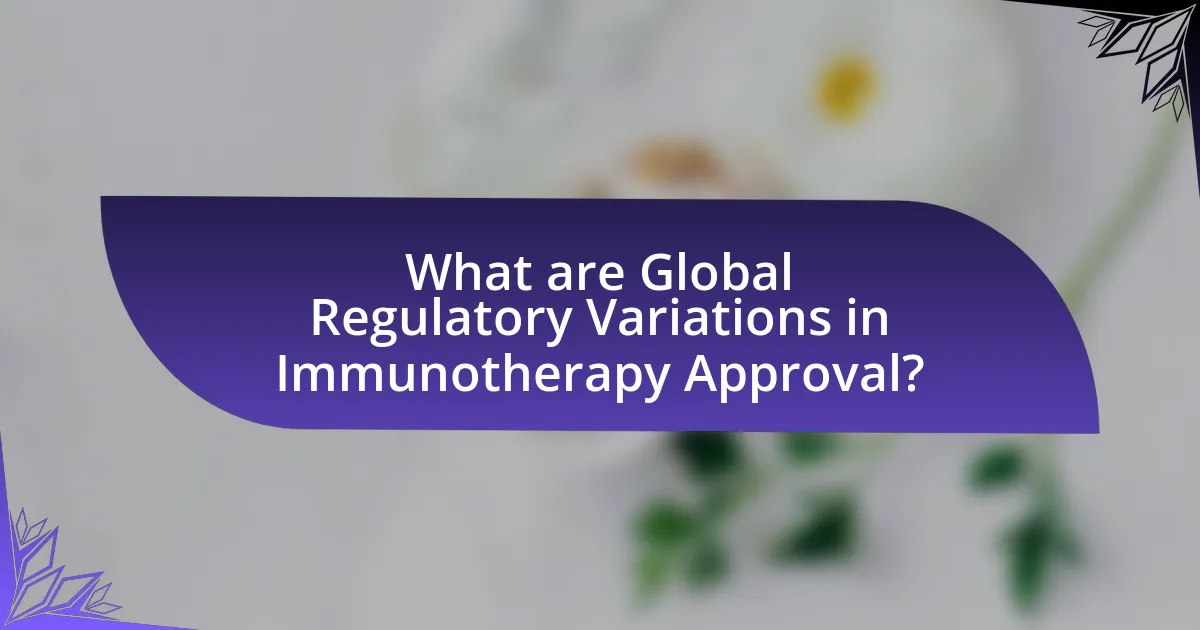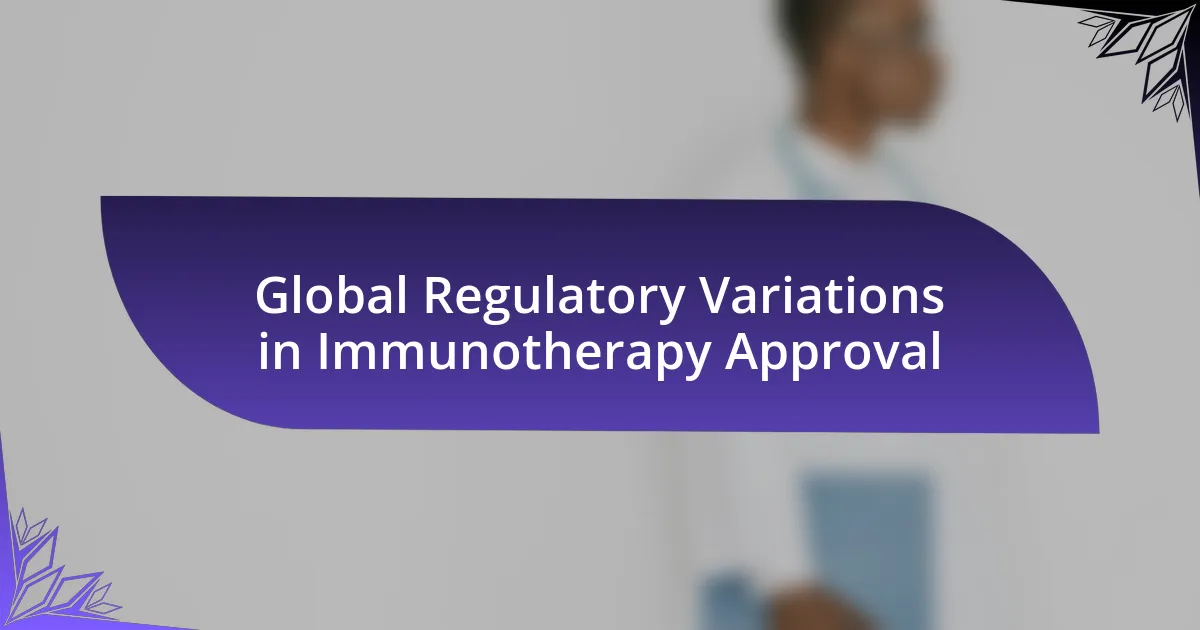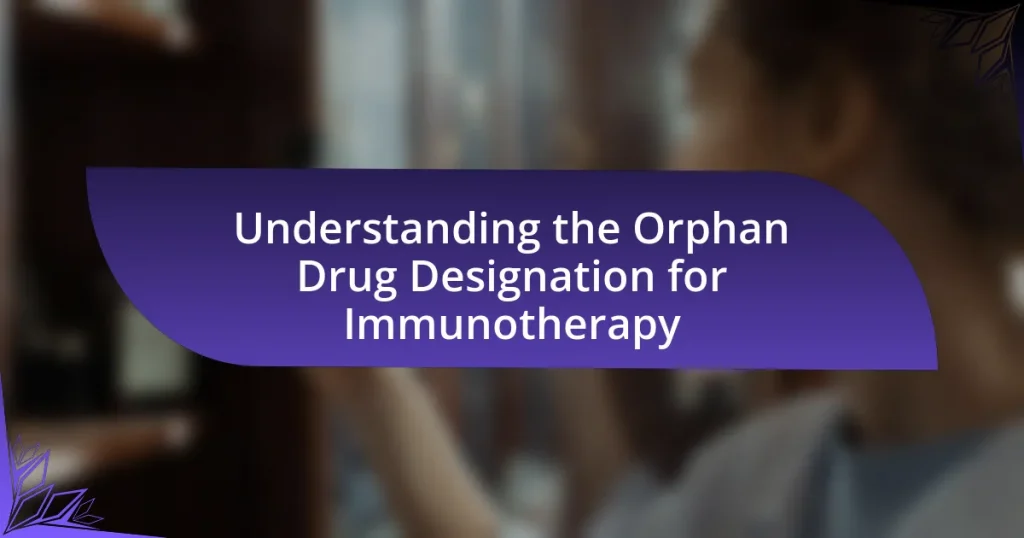Global regulatory variations in immunotherapy approval highlight the differences in evaluation processes and criteria employed by regulatory agencies across countries, such as the FDA in the U.S., the EMA in Europe, and the PMDA in Japan. These variations can significantly affect the speed at which new immunotherapies become available to patients, influenced by factors such as legal frameworks, cultural attitudes, and economic conditions. The article examines the implications of these discrepancies for pharmaceutical companies, the assessment criteria used by regulatory bodies, and the unique challenges faced by emerging markets. Additionally, it discusses future trends in harmonizing regulations and the role of technology and advocacy groups in shaping the regulatory landscape for immunotherapy.

What are Global Regulatory Variations in Immunotherapy Approval?
Global regulatory variations in immunotherapy approval refer to the differences in the processes and criteria used by various countries’ regulatory agencies to evaluate and authorize immunotherapy treatments. For instance, the U.S. Food and Drug Administration (FDA) may have different clinical trial requirements and approval timelines compared to the European Medicines Agency (EMA) or Japan’s Pharmaceuticals and Medical Devices Agency (PMDA). These variations can impact the speed at which new immunotherapies reach patients, as seen in the approval of checkpoint inhibitors, where the FDA may grant accelerated approval based on early efficacy signals, while other agencies might require more extensive data before approval. Such differences can lead to disparities in patient access to innovative treatments across regions.
Why do regulatory variations exist across different countries?
Regulatory variations exist across different countries due to differences in legal frameworks, cultural values, economic conditions, and public health priorities. Each country develops its regulatory policies based on its unique context, which influences how it evaluates and approves medical treatments, including immunotherapies. For instance, the United States Food and Drug Administration (FDA) may prioritize rapid access to innovative therapies, while the European Medicines Agency (EMA) may emphasize comprehensive safety data. These differing approaches reflect the countries’ respective healthcare systems, risk tolerance levels, and societal expectations regarding medical interventions.
What factors contribute to these regulatory differences?
Regulatory differences in immunotherapy approval are primarily influenced by variations in national health policies, scientific standards, and economic considerations. Each country establishes its own regulatory framework based on its healthcare priorities, which can lead to differing requirements for clinical trial data, safety assessments, and efficacy benchmarks. For instance, the U.S. Food and Drug Administration (FDA) may prioritize expedited access for breakthrough therapies, while the European Medicines Agency (EMA) may emphasize comprehensive long-term safety data. Additionally, economic factors such as healthcare costs and market access strategies can shape regulatory approaches, as seen in countries with stringent cost-effectiveness analyses before drug approval. These factors collectively contribute to the observed regulatory discrepancies in immunotherapy approval across different regions.
How do cultural attitudes towards healthcare influence regulations?
Cultural attitudes towards healthcare significantly influence regulations by shaping public expectations, trust in medical systems, and the prioritization of health issues. For instance, in cultures that emphasize individual autonomy, regulations may focus on informed consent and patient rights, leading to more stringent requirements for clinical trials. Conversely, in collectivist societies, regulations might prioritize community health outcomes, resulting in a focus on equitable access to treatments. Evidence from various countries shows that these cultural perspectives directly impact the speed and nature of regulatory approvals; for example, Japan’s emphasis on traditional medicine has led to unique regulatory pathways for integrating new therapies with established practices. Thus, cultural attitudes are pivotal in determining how healthcare regulations are formulated and implemented.
What is the significance of immunotherapy in modern medicine?
Immunotherapy is significant in modern medicine as it represents a transformative approach to treating various diseases, particularly cancer, by harnessing the body’s immune system to fight pathogens and tumors. This method has led to improved survival rates and quality of life for patients, with therapies such as checkpoint inhibitors and CAR T-cell therapy demonstrating substantial efficacy. For instance, the introduction of pembrolizumab, a PD-1 inhibitor, has shown a 40% response rate in melanoma patients, highlighting the potential of immunotherapy to achieve durable responses where traditional therapies have failed. Additionally, immunotherapy is expanding beyond oncology into autoimmune diseases and infectious diseases, showcasing its versatility and importance in contemporary therapeutic strategies.
How does immunotherapy differ from traditional treatments?
Immunotherapy differs from traditional treatments primarily in its mechanism of action; while traditional treatments like chemotherapy and radiation directly target and kill cancer cells, immunotherapy enhances the body’s immune system to recognize and attack cancer cells. Traditional treatments often have systemic side effects due to their non-specific nature, affecting both healthy and cancerous cells, whereas immunotherapy aims to specifically target cancer cells, potentially leading to fewer side effects. For instance, the use of immune checkpoint inhibitors, a type of immunotherapy, has shown significant efficacy in various cancers, with studies indicating improved survival rates compared to traditional therapies.
What are the potential benefits of immunotherapy for patients?
Immunotherapy offers several potential benefits for patients, including enhanced immune response against cancer cells, reduced side effects compared to traditional treatments, and the possibility of long-lasting remission. Studies have shown that immunotherapy can lead to durable responses in certain cancers, with some patients experiencing significant tumor shrinkage or complete remission. For instance, the use of immune checkpoint inhibitors has resulted in a 20-30% response rate in melanoma patients, demonstrating its effectiveness. Additionally, immunotherapy can be tailored to individual patients, allowing for personalized treatment approaches that may improve outcomes.
How do regulatory bodies assess immunotherapy applications?
Regulatory bodies assess immunotherapy applications through a rigorous evaluation process that includes reviewing clinical trial data, safety profiles, and efficacy results. These assessments typically involve multiple phases, including preclinical studies, Phase I to III clinical trials, and post-marketing surveillance. For instance, the U.S. Food and Drug Administration (FDA) requires substantial evidence from well-controlled trials demonstrating that the immunotherapy is safe and effective for its intended use. Additionally, regulatory agencies may consult advisory committees and consider patient population characteristics, treatment protocols, and potential benefits versus risks before granting approval. This structured approach ensures that only therapies meeting stringent safety and efficacy standards are made available to patients.
What criteria are used for evaluating immunotherapy safety and efficacy?
The criteria used for evaluating immunotherapy safety and efficacy include clinical trial endpoints, adverse event monitoring, and biomarker analysis. Clinical trial endpoints typically focus on overall survival, progression-free survival, and response rates, which provide quantitative measures of treatment effectiveness. Adverse event monitoring involves systematic reporting and assessment of side effects to ensure patient safety, with specific attention to immune-related adverse events that may arise from immunotherapy. Biomarker analysis is utilized to identify patient populations that are more likely to benefit from treatment, enhancing the understanding of efficacy in specific subgroups. These criteria are essential for regulatory agencies, such as the FDA and EMA, to determine the risk-benefit profile of immunotherapies before approval.
How do clinical trial requirements vary by region?
Clinical trial requirements vary significantly by region due to differing regulatory frameworks and health authority guidelines. For instance, the United States, governed by the FDA, mandates extensive preclinical data and phase trials, while the European Medicines Agency (EMA) emphasizes a more collaborative approach with sponsors during the trial design phase. In Asia, countries like Japan and China have unique requirements, such as the need for local clinical data to support efficacy claims, reflecting regional health priorities and patient demographics. These variations are influenced by factors such as ethical considerations, cultural attitudes towards clinical research, and the specific health challenges faced by populations in different regions.
What are the implications of regulatory variations for pharmaceutical companies?
Regulatory variations significantly impact pharmaceutical companies by creating challenges in compliance, market access, and product development timelines. These companies must navigate differing approval processes, which can lead to delays in bringing immunotherapy products to market. For instance, the U.S. Food and Drug Administration (FDA) and the European Medicines Agency (EMA) have distinct requirements for clinical trial data and safety assessments, resulting in increased costs and extended timelines for companies seeking approval in multiple regions. Furthermore, variations can lead to inconsistent labeling and marketing strategies, complicating global commercialization efforts. According to a study published in the Journal of Pharmaceutical Sciences, companies face an average of 18 months of additional time due to regulatory discrepancies when launching products in different markets.
How do these variations affect drug development timelines?
Global regulatory variations in immunotherapy approval significantly impact drug development timelines by introducing discrepancies in the approval processes across different regions. These variations can lead to delays in clinical trial initiation, as companies must navigate diverse regulatory requirements, which can extend the time needed for obtaining necessary approvals. For instance, the U.S. Food and Drug Administration (FDA) may have different data requirements compared to the European Medicines Agency (EMA), causing companies to adjust their development strategies and timelines accordingly. Consequently, these regulatory differences can result in an overall increase in the time it takes to bring a drug to market, with studies indicating that such variations can add several months to years to the development process.
What strategies can companies employ to navigate these differences?
Companies can employ several strategies to navigate global regulatory variations in immunotherapy approval. First, they should establish a comprehensive understanding of the regulatory frameworks in each target market, which involves conducting thorough research on local regulations and guidelines. For instance, the U.S. Food and Drug Administration (FDA) and the European Medicines Agency (EMA) have distinct approval processes, necessitating tailored approaches for each region.
Second, companies can engage local regulatory experts or consultants who possess in-depth knowledge of specific markets. This collaboration can facilitate smoother navigation through complex regulatory landscapes, as evidenced by successful case studies where companies reduced approval timelines by leveraging local expertise.
Third, companies should consider adopting a modular development approach, allowing them to adapt clinical trial designs to meet varying regulatory requirements across different jurisdictions. This strategy has been shown to enhance the efficiency of the approval process, as seen in the adaptive trial designs approved by both the FDA and EMA.
Finally, fostering strong relationships with regulatory authorities can lead to better communication and understanding, ultimately aiding in the approval process. Companies that actively engage with regulators often experience fewer delays and more favorable outcomes, as demonstrated by firms that have successfully navigated the approval process through proactive dialogue with agencies.

How do specific countries approach immunotherapy approval?
Countries approach immunotherapy approval through varying regulatory frameworks and processes. In the United States, the Food and Drug Administration (FDA) employs a rigorous evaluation process that includes preclinical studies, clinical trials, and a New Drug Application (NDA) submission, often expedited through pathways like Breakthrough Therapy Designation for promising therapies. In contrast, the European Medicines Agency (EMA) utilizes a centralized procedure for marketing authorization, requiring comprehensive data on efficacy and safety, and often involves a scientific advice process to guide developers. Japan’s Pharmaceuticals and Medical Devices Agency (PMDA) emphasizes a collaborative review process, allowing for conditional approvals based on early clinical data, which can accelerate patient access. These approaches reflect each country’s regulatory priorities and frameworks, impacting the speed and accessibility of immunotherapy treatments.
What is the approval process in the United States?
The approval process in the United States for new drugs, including immunotherapies, is primarily governed by the Food and Drug Administration (FDA). This process involves several key stages: preclinical testing, Investigational New Drug (IND) application, clinical trials (Phases 1, 2, and 3), New Drug Application (NDA), and post-marketing surveillance.
During preclinical testing, researchers conduct laboratory and animal studies to gather efficacy and safety data. Following this, an IND application is submitted to the FDA, which must be approved before clinical trials can begin. Clinical trials are conducted in three phases, with each phase designed to assess safety, dosage, efficacy, and side effects in progressively larger groups of participants. After successful completion of these trials, a New Drug Application is submitted to the FDA for review. If approved, the drug can be marketed, but it remains subject to post-marketing surveillance to monitor long-term effects and safety in the general population.
This structured process ensures that new therapies meet rigorous safety and efficacy standards before they are made available to patients.
What role does the FDA play in immunotherapy regulation?
The FDA plays a critical role in the regulation of immunotherapy by overseeing the approval process for new therapies to ensure their safety and efficacy. This regulatory authority is established under the Federal Food, Drug, and Cosmetic Act, which mandates that any new drug, including immunotherapies, must undergo rigorous clinical trials and review before reaching the market. The FDA evaluates data from these trials, assessing factors such as the treatment’s effectiveness against specific diseases, potential side effects, and overall patient safety. In 2021, the FDA approved 14 new immunotherapy products, demonstrating its active involvement in advancing cancer treatment options while maintaining stringent safety standards.
How do post-marketing surveillance practices differ in the U.S.?
Post-marketing surveillance practices in the U.S. differ primarily in their regulatory framework and data collection methods compared to other countries. The U.S. Food and Drug Administration (FDA) employs a system that includes mandatory reporting of adverse events by manufacturers and healthcare providers, as outlined in the FDA Amendments Act of 2007, which expanded the agency’s authority to monitor drug safety post-approval. Additionally, the FDA utilizes the Sentinel Initiative, a national electronic system for monitoring the safety of medical products, which allows for real-time data analysis from various healthcare databases. This contrasts with practices in some other countries, where post-marketing surveillance may rely more heavily on voluntary reporting systems and less comprehensive data integration.
How does the European Union regulate immunotherapy?
The European Union regulates immunotherapy primarily through the European Medicines Agency (EMA), which evaluates and approves medicinal products, including immunotherapies. The EMA follows a centralized procedure for the authorization of new therapies, ensuring that they meet stringent safety, efficacy, and quality standards before being marketed across EU member states. This process includes comprehensive clinical trials and assessments, guided by regulations such as the EU Clinical Trials Regulation (EU) No 536/2014, which aims to enhance patient safety and data transparency. Additionally, the EMA provides guidelines specific to immunotherapies, addressing unique aspects such as biomarker development and patient selection, thereby ensuring that these innovative treatments are both effective and safe for patients.
What is the role of the European Medicines Agency (EMA)?
The European Medicines Agency (EMA) is responsible for the scientific evaluation, supervision, and safety monitoring of medicines in the European Union. The EMA’s primary role includes assessing applications for marketing authorization of new drugs, including immunotherapies, ensuring they meet rigorous safety and efficacy standards. The agency also provides scientific advice and guidance to pharmaceutical companies during the development of new therapies, facilitating the approval process. Additionally, the EMA monitors the safety of medicines post-authorization through pharmacovigilance activities, ensuring ongoing compliance with regulatory standards.
How do member states influence the approval process?
Member states influence the approval process of immunotherapy by establishing their own regulatory frameworks and guidelines that govern the evaluation and authorization of new treatments. Each member state can set specific requirements for clinical trials, data submission, and post-marketing surveillance, which can lead to variations in the approval timelines and criteria across different jurisdictions. For instance, the European Medicines Agency (EMA) provides a centralized approval process, but individual member states retain the authority to implement additional national regulations that may affect the speed and conditions under which therapies are approved. This decentralized approach can result in discrepancies in access to immunotherapy treatments, as some countries may prioritize certain therapies over others based on local health policies and economic considerations.
What unique challenges do emerging markets face in immunotherapy approval?
Emerging markets face unique challenges in immunotherapy approval primarily due to regulatory inconsistencies and limited resources. These markets often lack established regulatory frameworks that are comparable to those in developed countries, leading to delays in the approval process. For instance, the World Health Organization reports that many emerging economies have under-resourced regulatory agencies, which struggle to keep pace with the rapid advancements in immunotherapy. Additionally, there is often a lack of clinical trial infrastructure and expertise, which hampers the ability to conduct necessary studies that meet international standards. This situation is compounded by economic constraints that limit access to innovative therapies, further delaying patient access to potentially life-saving treatments.
How do resource limitations impact regulatory processes?
Resource limitations significantly hinder regulatory processes by restricting the capacity of regulatory agencies to conduct thorough evaluations and oversight. When agencies face budget constraints, they may lack sufficient personnel, technology, and training, leading to delays in the review of applications and approvals for immunotherapy treatments. For instance, the U.S. Food and Drug Administration (FDA) has reported that increased workload without corresponding budget increases can result in longer review times, impacting timely access to innovative therapies. Additionally, limited resources can lead to prioritization of certain applications over others, potentially stalling the approval of critical immunotherapies that could benefit patients.
What are the common barriers to access in these regions?
Common barriers to access in regions with global regulatory variations in immunotherapy approval include stringent regulatory requirements, limited healthcare infrastructure, and economic constraints. Stringent regulatory requirements can delay the approval process for new therapies, as seen in regions with complex clinical trial regulations. Limited healthcare infrastructure often results in inadequate distribution of approved therapies, particularly in rural or underserved areas. Economic constraints further exacerbate access issues, as high costs of immunotherapy can make it unaffordable for many patients, leading to disparities in treatment availability.

What are the future trends in global immunotherapy regulation?
Future trends in global immunotherapy regulation include increased harmonization of approval processes, enhanced post-market surveillance, and a focus on patient-centric approaches. Regulatory bodies, such as the FDA and EMA, are collaborating to streamline guidelines, which aims to reduce the time and cost associated with bringing new therapies to market. Additionally, there is a growing emphasis on real-world evidence and adaptive trial designs, allowing for more flexible and responsive regulatory frameworks. This shift is supported by the increasing complexity of immunotherapies and the need for ongoing safety monitoring, as evidenced by the rise in adverse event reporting systems. Furthermore, patient engagement in the regulatory process is becoming more prominent, reflecting a broader trend towards personalized medicine and the incorporation of patient perspectives in decision-making.
How might international collaboration improve regulatory consistency?
International collaboration can improve regulatory consistency by harmonizing standards and practices across countries. When regulatory bodies work together, they can share data, best practices, and experiences, leading to unified guidelines that reduce discrepancies in approval processes. For instance, initiatives like the International Council for Harmonisation of Technical Requirements for Pharmaceuticals for Human Use (ICH) have successfully aligned regulatory requirements among major markets, facilitating smoother drug approvals. This collaborative approach not only enhances the efficiency of the regulatory process but also fosters trust among stakeholders, ultimately benefiting patient access to innovative therapies like immunotherapies.
What initiatives are currently in place to harmonize regulations?
Currently, initiatives to harmonize regulations in immunotherapy approval include the International Council for Harmonisation of Technical Requirements for Pharmaceuticals for Human Use (ICH) guidelines and the efforts of the World Health Organization (WHO) to establish global standards. The ICH provides a framework that facilitates the mutual acceptance of data among regulatory authorities, thereby streamlining the approval process across different regions. Additionally, WHO’s initiatives aim to enhance regulatory capacity and promote collaboration among member states, which supports the alignment of regulatory practices. These efforts are crucial for reducing discrepancies in immunotherapy approvals and ensuring patient access to innovative treatments globally.
How can technology facilitate better regulatory practices?
Technology can facilitate better regulatory practices by enhancing data collection, analysis, and communication among stakeholders. Advanced data analytics tools enable regulators to assess large volumes of clinical trial data more efficiently, leading to informed decision-making. For instance, the use of artificial intelligence in evaluating safety and efficacy data can reduce the time required for regulatory reviews, as demonstrated by the FDA’s use of AI algorithms to expedite the approval process for certain therapies. Additionally, digital platforms improve transparency and collaboration between regulatory bodies, pharmaceutical companies, and healthcare providers, fostering a more streamlined approval process. This integration of technology ultimately leads to more timely access to innovative treatments while ensuring patient safety and compliance with regulatory standards.
What best practices can stakeholders adopt to navigate regulatory variations?
Stakeholders can adopt several best practices to navigate regulatory variations effectively. First, they should establish a comprehensive understanding of the regulatory landscape in each jurisdiction, which includes familiarizing themselves with specific requirements and timelines for immunotherapy approvals. This knowledge enables stakeholders to anticipate challenges and streamline their processes.
Additionally, stakeholders should engage with local regulatory authorities early in the development process to clarify expectations and gain insights into potential hurdles. This proactive communication can lead to more efficient submissions and approvals.
Furthermore, stakeholders can benefit from collaborating with local experts or consultants who possess in-depth knowledge of regional regulations. These partnerships can provide valuable guidance and help navigate complex regulatory environments.
Lastly, maintaining flexibility in development strategies allows stakeholders to adapt to changing regulations and emerging data, ensuring compliance while optimizing the approval process. This adaptability is crucial in the rapidly evolving field of immunotherapy.
How can companies stay informed about changing regulations?
Companies can stay informed about changing regulations by actively monitoring regulatory agency announcements and subscribing to industry newsletters. Regulatory agencies, such as the FDA and EMA, frequently publish updates on their websites regarding new guidelines and changes in approval processes. Additionally, industry associations often provide resources and updates on regulatory changes relevant to immunotherapy. Research indicates that companies that engage in regular communication with regulatory consultants and legal experts are better equipped to navigate the complexities of evolving regulations, ensuring compliance and timely adaptation to new requirements.
What role do advocacy groups play in shaping regulatory landscapes?
Advocacy groups play a crucial role in shaping regulatory landscapes by influencing policy decisions and promoting public awareness on specific issues. These organizations mobilize stakeholders, conduct research, and provide expert testimony to regulatory bodies, thereby impacting the development and implementation of regulations. For instance, advocacy groups in the healthcare sector often lobby for more favorable drug approval processes, which can lead to expedited access to treatments like immunotherapies. Their efforts can result in changes to regulatory frameworks, as seen in the case of the FDA’s accelerated approval pathway, which was influenced by patient advocacy for quicker access to life-saving therapies.



